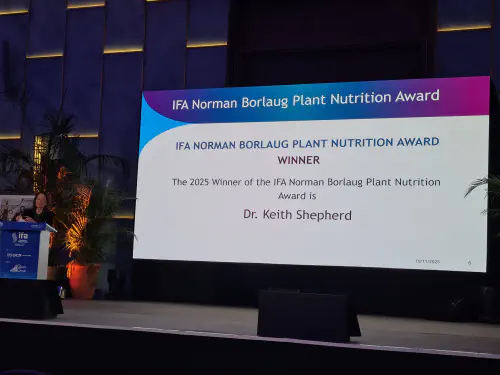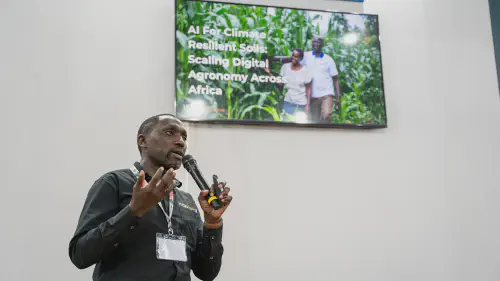Uganda’s agricultural sector plays a vital role in driving economic growth, reducing poverty and ensuring national food security. Contributing around 24% to GDP and employing over 70% of the population, agriculture is the country’s economic backbone. Yet with most farming rain-fed and subsistence-based, the sector remains highly vulnerable to climate change - especially to increasingly frequent and severe droughts. By 2050, climate impacts are projected to cause economic losses of up to US$1.5 billion for smallholder farmers across Africa. Their livelihoods - and national food systems - are under growing threat. That’s why iSDA is building tools that combine world-class science with cutting-edge technology to help farmers adapt. At the centre of this work is Virtual Agronomist (VA) - our AI-powered advisory tool, delivered via WhatsApp, that provides data-driven, hyper-local advice to farmers across Africa. What makes VA different is its foundation in science: it generates fertiliser and nutrient management plans tailored to individual plots, using high-resolution soil data from iSDAsoil, Africa’s most detailed soil mapping platform. By pairing soil diagnostics with real-time insights on pests, disease and weather, Virtual Agronomist helps farmers make smarter decisions - boosting productivity and building resilience to climate shocks.
Testing Virtual Agronomist in Uganda
In early 2025, we rolled out a pilot of Virtual Agronomist with sunflower farmers in Bulambuli, an eastern Ugandan district where sunflower is an increasingly popular cash crop. We then conducted a survey to compare the outcomes of VA users against those following typical Farmer Practices (FP). The goal? To test whether AI-powered advice could support better yields, more efficient input use and lead to stronger profits - despite the climate and resource constraints farmers face.
Why Sunflower? Why Bulambuli?
Climate-smart agriculture - rooted in resilience, productivity and sustainability - offers a critical pathway forward. In Uganda, sunflower is emerging as a promising climate-resilient crop among smallholders. Supported by initiatives like the Vegetable Oil Development Project and CRAFT East Africa, sunflower farming is increasingly seen as a route to better incomes. Yet, only 24% of sunflower farmers currently have access to extension services, and yields typically range between just 890–2400 kg/ha.
Bulambuli’s combination of opportunity and unmet advisory needs made it an ideal testing ground for Virtual Agronomist.
What Was the Purpose of the Bulambuli Survey?
The aim of the pilot and survey was to assess the real-world impact of Virtual Agronomist compared to traditional farmer practices. Specifically, we wanted to evaluate:
- Differences in yield and profitability
- Adoption of fertiliser and pest management recommendations
- Farmer trust in digital tools
- Operational insights to improve the platform The pilot also allowed us to test how iSDAsoil-informed nutrient plans perform in live farming environments - showing how localised data and AI can combine to improve farmer decision-making at scale.
Survey Setup
We surveyed 100 farmers using Virtual Agronomist for fertiliser advice and nutrient planning and compared them with a control group of 106 farmers using standard practices. Led by iSDA agronomist Paul Chunga, the study team included 10 enumerators and 5 lead farmers. Data collected included field measurements, yield records, and input usage - forming the baseline for evaluating outcomes and identifying improvement areas.
Key Findings
1. Significant Yield Increases with Virtual Agronomist
- VA farmers averaged 3.1 t/ha, compared to 2.4 t/ha for the FP group - a 1.27x yield increase
- The yield increase rose to 1.43x for 25% of the highest yielding farmers.
2. Fertiliser Use and Timing Matter
- Yield strongly correlated with fertiliser spend among VA farmers
- 21% of VA farmers applied basal fertiliser late - causing a 0.92 t/ha yield penalty
- 46% of VA farmers applied topdressing fertiliser, versus just 7% in the FP group
- VA users employed more diverse and appropriate basal fertiliser mixes, tailored to soil diagnostics
3. Weeds, Pests & Crop Management
- Farmers cited weeds, drought and theft as top challenges
- Weed control had a major yield impact. Farmers without weed issues averaged 2.8 t/ha vs 2 t/ha for those with weed pressure
- 33% of VA farmers employed a controlled use of pesticides, versus 11% of FP farmers - a sign of more proactive management
4. Profits Reflect Yield Gains
- VA farmers earned $881/ha, compared to $707/ha for FP — a 1.24x profit gain
- 19% of VA farmers made over $1200/ha, versus just 4% in the FP group
- No VA farmer reported a loss, even after factoring in fertiliser spend
- Using self-reported fertiliser costs, VA farmers still showed a 1.17x profit advantage
Tools Farmers Trust
When asked which tools within Virtual Agronomist were most useful, farmers consistently rated iSDAsoil diagnostics and nutrient plans the highest – especially given these are tailored to their actual plots.
This reaffirms a core belief we have at iSDA: equipping farmers with plot-specific soil knowledge is essential. In Africa, extreme soil variability means that generic recommendations often fall short. By contrast, Virtual Agronomist’s soil-specific guidance gave farmers an actionable starting point - helping them optimise fertiliser use, improve soil health and avoid costly missteps. Farmers also ranked the pest and disease diagnosis tools within Virtual Agronomist highly, reinforcing the value of real-time, farm-level insights powered by AI and backed by agronomists.
So, What’s Next?
The Bulambuli pilot is just one step in our mission to make climate-smart, AI-powered agricultural advisory accessible to every African farmer. We are expanding the pilot to a wider range of crops, including popular legumes, such as cowpea, and vegetables such as tomatoes and onions. We are also working on better ways to measure how much yield gains are tied to following Virtual Agronomist advice and what gets in the way of using it.
Want to partner on a localised pilot, integrate Virtual Agronomist into your programme, or request the full data pack when it’s ready?
Latest Stories
Here’s what we've been up to recently.



